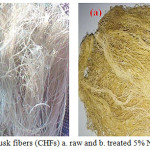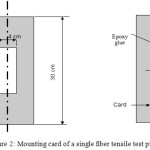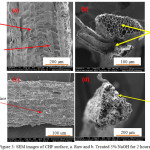The Effect of Sodium Hydroxide on Chemical and Mechanical Properties of Corn Husk Fiber
Nasmi Herlina Sari1 , I. N. G. Wardana2, Yudy Surya Irawan2 and Eko Siswanto2
, I. N. G. Wardana2, Yudy Surya Irawan2 and Eko Siswanto2
1Department of Mechanical Engineering, Mataram University, Mataram, NTB, Indonesia.
2Department of Mechanical Engineering, Brawijaya University, East Java, Indonesia.
Corresponding Author E-mail: nasmiherlina336@gmail.com
DOI : http://dx.doi.org/10.13005/ojc/330642
There are thousands of different fibers in the world and in fact, only a few of these fibers have been studied. This report concentrates on the chemical, and mechanical properties of corn husk fibers treated NaOH 5% for 2 h.The outcome indicates that the alkali treatment with NaOH 5% removed the hemicelluloses and lignin in the fibers and decreased the moisture content. Consequently, the higher cellulose content obtained by 54.37%, and mechanical properties of fibers were greatly improved of 237.43 ± 104.82. Moreover, their properties are comparable to most natural fiber. Scanning electron microscopy analysis indicated the presence of rough surfaces and a number of lumens inside the fiber bundles. These valuable of data very encouraging the usage of Corn husk fibers (CHFs) for the application in fiber industries, composite manufacturing, etc.
KEYWORDS:Corn husk fiber; chemical properties; mechanical properties and scanning electron microscopy
Download this article as:| Copy the following to cite this article: Sari N. H, Wardana I. N. G, Irawan Y. S, Siswanto E. The Effect of Sodium Hydroxide on Chemical and Mechanical Properties of Corn Husk Fiber. Orient J Chem 2017;33(6). |
| Copy the following to cite this URL: Sari N. H, Wardana I. N. G, Irawan Y. S, Siswanto E. The Effect of Sodium Hydroxide on Chemical and Mechanical Properties of Corn Husk Fiber. Orient J Chem 2017;33(6). Available from: http://www.orientjchem.org/?p=40772 |
Introduction
Natural fibers from wood and annual crops are widely available in most developing countries such as Agave bagasse (Robles, et al., 2015), sansieviera (Sreenivasan et al., 2011), and kenaf (Alavudeen et al., 2015) etc. They provide several advantages compared to synthetic fibers since low density, renewability, abundant, inexpensive, and eco-friendly are offered (Jawaid & Khalil, 2015; Sari et al., 2016; Bledzki et al., 2015). Until now, natural fibers have been used to reinforce composite materials and has been applied in building construction, sound absorbent, and automotive (Sari et al., 2016). This has opened up opportunities other natural fibers to be investigated and be an alternative to strengthen the composite material.
One of the available natural fiber sources that its properties still needs to be investigated is corn husk waste which is cheap, sustainable and environmentally friendly. Besides supplying the data for different industrial sectors, comprehensive characterization of plant fibers also enables new uses for these abundantly available resources with cost-effective extraction processes without impairing the fibers properties for the development of bio-composites (Satyanarayana, Guimarães, & Wypych, 2007).
However, the use of natural fibers as a composite reinforcement is less attractive, due to the hydrophilic nature of fibers containing high polar hydroxyl groups resulting in fiber compatibility with low polymer resins and easily degradable and rapidly decaying fibers (Kabir et al., 2012; Yan, Chouw, & Jayaraman, 2014). Therefore, natural fibers should be pre-treated prior to use as a composite reinforcement. Alkali treatment with NaOH is a method used to improve the properties of natural fibers. Furthermore, the use of alkali with NaOH in fiber can provide an increase in cellulose content, mechanical properties and water resistance properties of the fibers.
The present work is based on the natural fiber from corn husk (Zea May. L) aimed to provide data and discussion on the improvement of chemical, and mechanical properties and changes in the surface structure of corn husks by NaOH 5% treatment.
Materials and Methods
Materials
Corn husk fibers (CHFs) were obtained from the waste of corn husk. They were collected from central Lombok area, West Nusa Tenggara, Indonesian. The average width and length of the corn husks were 11–13.5 cm and 24 – 24.5 cm, respectively. The choosing process is directed to maintain the uniformity of the selected corn husk fiber.
Fiber Bundles Extraction
The corn husks were soaked in water for sixteen days to undergo the micro-bacterial degradation process (Saravanakumar et al., 2013). They were then taken out with a plastic brush and thoroughly washed in fresh water. The retained inner layer is a bundle of fibers which can be separated for further use. Raw CHFs were retrieved and dried naturally by winds. CHFs raw can be seen in Figure 1a.
 |
Figure 1: Corn husk fibers (CHFs) a. raw and b. treated 5% NaOH for 2 hours. Click here to View figure |
Alkaline treatment of CHFs
Alkali treatment of CHFs was treated with 5% sodium hydroxide (NaOH) for 2 hours at room temperature (Hossain et al., 2014). The reaction is given below:
Fiber – OH + NaOH → Fiber – O– Na+ + H2O,
The CHFs was rinsed with plain water for five times to remove NaOH sticking on the fiber surface and dried in natural sunlight to remove moisture content. It was then being kept in plastic wrap and CHFs were stored in a dry box with 40% humidity. The fiber treated 5% NaOH can be shown in Figure 1b.
Chemical content of CHFs
The cellulose, hemicelluloses, lignin and silica contents of CHFs sample were found out by the standard of TAPPI methods. Soxhlet extraction (alcohol acetone) was carried out for 8 h. Chemical analysis of the CHFs and Klason lignin (acid insoluble) content calculation were performed according to TAPPI T203 om 93 and T222 om 88 respectively (Suryanto et al., 2013; Porras, Maranon, & Ashcroft, 2015). The hemicellulose content was determined according to Gatenholm, (2003). The result of the chemical composition of CHFs and the other natural cellulosic fibers are further compared to the available data of various review articles and tabulated in Table 1.
Moisture Content
The moisture content of raw and treated 5% NaOH of CHFs was determined by using a digital analytical balance with an accuracy of 0.0001 grams in a standard testing atmosphere of 29 oC and 64 % relative humidity. The dried test sample of 0.5 ± 0.0001 grams was put into a porcelain beaker. The porcelain beaker, as well as the samples, were put into an oven and heated for 4 hours at a temperature of 105 oC. The moisture content in the CHFs was determined by equation (1.1) (Suryanto et al. 2013; Sreenivasan et al. 2011):
WCHFs = {(W2 – W1)/(W2)} x 100% (1.1)
Where
WCHFs = the moisture content of the CHFs (%)
W2 = the sample weight before drying (gram)
W1 = the sample weight after drying (gram).
Mechanical Properties of CHFs
Fiber bundles of raw and treated 5% NaOH were separated. The Young’s modulus and tensile strength were determined using universal testing machines a Tensilon RTG 1310 at the constant crosshead speed of 2.5 mm/min and load cell 10 KN. A gauge length of 2.5 cm was used for tensile testing, according to ASTM D3379-75 (Alawar et al. 2009). Before each test, the mean diameter of the fibers was measured by Mitutoyo digital micrometer, with an accuracy of 0.0001 cm. Each sample of CHFs raw and treated of the test was repeated three times in order to have average measurements. A single fiber was prepared for the test within a card mounting as shown in Figure 2.
 |
Figure 2: Mounting card of a single fiber tensile test piece Click here to View figure |
Scanning Electron Microscope (SEM) Analysis of the CHFs
The surface morphologies of the CHFs raw and alkali treated were observed by using FEI model and Inspect-S50-type scanning electron microscope (SEM) with field emission gun. An accelerating voltage of 10 kV was used to collect SEM images of the surface of CHFs raw and alkali treated CHFs. Before testing, the samples were sliced and mounted on SEM stubs with double-sided adhesive tape. Then gold sputtered for 5 min to a thickness of about 10 nm under 0.1 torr pressure and 18 mA current were employed to make the sample conductive. Micrographs were recorded at different magnifications to assure clear images.
Results and Discussion
Chemical Properties of CHFs
The results of chemical analysis of CHFs raw and treated NaOH are shown in Table 1. The result of measurement of chemical content from raw CHFs such as cellulose, hemicellulose, and lignin has been known as 46.15%, 33.79%, and 8.92% respectively. Alkali treatment of 5% NaOH in fiber has decreased hemicellulose and lignin content by 22.37% and 5.64% respectively. The loss of hemicellulose and lignin in large quantities has led to the cellulose percentage increase of 54.37%. Compared with other natural fibers, the cellulose content of CHFs after treated 5% NaOH is higher than the Kenaf fiber, and close to the cellulose value possessed by Agave Bagasse fibers.
The chemical properties of raw and treated CHF compared to other natural fibers can be seen in Table 1. The behavior of natural fibers is determined by the chemical content of the fiber. Cellulose contributed to the mechanical strength of the fiber through hydrogen bonding and other links. Hemicellulose contributed to the water absorption of the fibers (Faruk et al., 2014; Suryanto et al., 2013). Lignin contributes to the strength and stiffness of the fibers, but lignin has a negative effect on the structure and morphology of the fibers (Indran & Raj, 2015).
Table 1: Chemical properties of CHFs in comparison with cellulose-based natural fibers.
| Fibertypes | Cellulose(%) | Hemicellulose(%) | Lignin(%) | References |
| CHFs | 46.15 | 33.79 | 8.92 | Determination |
| CHFs treated NaOH 5% | 54.37 | 22.37 | 5.64 | Determination |
| MFs | 72.14 | 20.22 | 3.44 | (Suryanto et al., 2013) |
| Manicaria fabric | 64.39 | 0.5 | 32.99 | (Porras et al., 2015) |
| Kenaf | 44-57 | 21 | 15-19 | (Alavudeen et al. (2015) |
| Agave Bagasse | 54.60 | 13.95 | 16.2 | (Robles et al., 2015) |
| Curaua | 73.6 | 9.9 | 7.5 | (Faruk et al., 2012) |
| Manicaria | 74.1 | 12.0 | 31.1 | (Porras et al., 2015) |
| Wheat straw | 71.24 | 23.22 | 5.54 | (Zou, Huda & Yang, 2010) |
Moisture Content
The moisture content of the CHFs raw of 11.98 % is significantly higher than the other natural fibers such as mendong fibers of 4.2 – 5.2 (%), coir (8 %) etc (Suryanto et al., 2013; Faruk et al., 2012). A High moisture absorption of raw fiber is caused by the degradation and disintegration of microfibril occurred (Faruk et al., 2014; Indran et al., 2014). However, after CHF was given alkaline treatment, the fiber moisture content decreased to 11.187%. The value of this moisture is lower than sisal 10 – 22 (%) (Faruk et al., 2012). It indicated that alkali treatment of CHF has removed the hemicellulose content of the fibers, causing the moisture content of the fiber to decrease. Under alkali treatment, the interstices between the groups of microfibrils of the fiber would be blocked by the linked agents which reduce the water accessibility (Sreekala & Thomas, 2003). This may give interfacial bond strength at polymer matrix when CHFs are used as reinforcement in a composite manufacturing.
Mechanical Properties
Compared to raw fibers, the improved strength was observed to be around 47.9% to 5% of NaOH. The maximum tensile strength was reported at 5% NaOH treatment. The improvement in the tensile strength of raw fiber compares to that with5 % NaOH treated fibers exceeded 237.43 ± 104.82Mpa. The increase in tensile strength is associated with the decrease in fiber diameter because of the loss of hemicellulose in the fibers due to alkali treatment, as shown in Table 2. Furthermore, under alkali treatment with 5% NaOH, the percentage of cellulose content in the fiber increases to produce high tensile strength of the fibers. The tensile strength of raw and treated CHFs were higher than that of fiberglass (tensile strength of fiberglass =1.7–3.5 Mpa; Pothan et al. 2005).
Table 2: Mechanical properties of raw and treated corn husk fibers.
| Material (CHFs) | Diameter(mm) | Gauge length (mm) | Tensile strength(Mpa) | Young’s modulus(GPa) | Elongation(%) |
| Raw | 0.186 ± 0.02 | 25 | 160.49 ± 17.12 | 4.57 ± 0.54 | 21,08 ± 2.860 |
| Treated (5% NaOH) | 0.133 ± 0.03 | 25 | 237.43 ± 104.82 | 9.19 ± 3.68 | 11.35 ± 4.48 |
SEM Analysis
The fiber surfaces of the raw CHFs were relatively smooth and the presence of lumens located in fiber bundles as seen in Figure 3a. This morphology is attributed to the thick outer layers of hemicellulose and lignin and other substances covering the CHF surfaces and protecting the cellulose inside. NaOH treatment removed several impurities from the fiber surfaces and caused fibrillation and the fibers became rougher as shown in Figure 3b. When lignocellulose fibers were used as reinforcing fibers in composite materials, the chemical surface treatment of the cellulose fibers allowed them to react with the fiber surfaces, forming a bridge of chemical bonds between the fibers and matrix (Ashori et al., 2012).
 |
Figure 3: SEM images of CHF surface, a. Raw and b. Treated 5% NaOH for 2 hours. Click here to View figure |
Conclusion
The characterization of the CHFs provides new hope for cellulose fiber to compete with other cellulose fiber with its excellent properties. The use of alkali with 5% NaOH in the fiber has decreased the hemicellulose and lignin content of the fiber surface. As a consequence, the cellulose content and the mechanical properties of the fibers increase very high. Under alkaline treatment, the fiber surface becomes rougher, cleaner and the fiber diameter becomes smaller.
References
- Robles, E., Urruzola, I., Labidi, J., & Serrano, L. Surface-modified nano-cellulose as reinforcement in poly ( lactic acid ) to conform new composites, .2015. 71, 44–53. http://doi.org/10.1016/j.indcrop.2015.03.075
CrossRef - Sreenivasan, V. S., Somasundaram, S., Ravindran, D., Manikandan, V., & Narayanasamy, R. Microstructural, physicochemical and mechanical characterisation of Sansevieria cylindrical fibres – An exploratory investigation. Materials and Design, 2011. 32(1), 453–461. http://doi.org/10.1016/j.matdes.2010.06.004
CrossRef - Alavudeen, A., Rajini, N., Karthikeyan, S., Thiruchitrambalam, M., & Venkateshwaren, N.. Mechanical properties of banana/kenaf fiber-reinforced hybrid polyester composites: Effect of woven fabric and random orientation. Materials & Design, 2015.,66, 246–257. http://doi.org/10.1016/j.matdes.2014.10.067
CrossRef - Jawaid, M., & Khalil, H. P. S. A. . Cellulosic / synthetic fibre reinforced polymer hybrid composites : A review. Carbohydrate Polymers, 2015.,86(1), 1–18. http://doi.org/10.1016/j.carbpol.2011.04.043
CrossRef - Sari, N. H., Wardana, I. N. G., Irawan, Y. S., & Siswanto, E.. Physical and Acoustical Properties of Corn Husk Fiber Panels. Hindawi Publishing Corporation, 2016.,2016, 1–8. http://doi.org/http://dx.doi.org/10.1155/2016/5971814
CrossRef - Bledzki, A. K., Franciszczak, P., Osman, Z., & Elbadawi, M. . Polypropylene biocomposites reinforced with softwood, abaca,jute, and kenaf fibers. Industrial Crops & Products, 2015.,70, 91–99. http://doi.org/10.1016/j.indcrop. 2015.03.013
- Satyanarayana, K. G., Guimarães, J. L., & Wypych, F.. Studies on lignocellulosic fibers of Brazil. Part I: Source, production, morphology, properties, and applications. Composites Part A: Applied Science and Manufacturing, 2007.,38(7), 1694–1709. http://doi.org/10.1016/j.compositesa.2007.02.006
CrossRef - Kabir, M. M., Wang, H., Lau, K. T., & Cardona, F.. Composites : Part B Chemical treatments on plant-based natural fibre reinforced polymer composites : An overview. Composites Part B, 2012.,43(7), 2883–2892. http://doi.org/10.1016/j.compositesb.2012.04.053
CrossRef - Yan, L., Chouw, N., & Jayaraman, K.. Composites : Part B Flax fibre and its composites – A review. Composites Part B, 2014.,56, 296–317. http://doi.org/10.1016/j.compositesb.2013.08.014
CrossRef - Saravanakumar, S. S., Kumaravel, A., Nagarajan, T., Sudhakar, P., & Baskaran, R. . Characterization of a novel natural cellulosic fiber from Prosopis juliflora bark. Carbohydrate Polymers, 2013., 92(2), 1928–1933. http://doi.org/10.1016/j.carbpol.2012.11.064
CrossRef - Suryanto, H., Marsyahyo, E., Irawan, Y. S., & Soenoko, R. . Morphology, Structure, and Mechanical Properties of Natural Cellulose Fiber from Mendong Grass ( Fimbristylis globulosa ). Journal of Natural Fibers, 2014, 37–41. http://doi.org/10.1080/15440478.2013.879087
CrossRef - Porras, A., Maranon, A., & Ashcroft, I. A.. Characterization of a novel natural cellulose fabric from Manicaria saccifera palm as possible reinforcement of composite materials. Composites Part B, 2015.,74, 66–73. http://doi.org/10.1016/j.compositesb.2014.12.033
CrossRef - Gatenholm, P., & Tenkanen, M.. Hemicelluloses : Science and Technology; ACS Symposium Series ; American Chemical Society, Washington, DC. In International Symposium on Xylans, Mannans, and Other Hemicelluloses. 2003
- Alawar, A., Hamed, A. M., & Al-Kaabi, K.. Characterization of treated date palm tree fiber as composite reinforcement. Composites Part B: Engineering, 2009.,40(7), 601–606. http://doi.org/10.1016/j.compositesb.2009.04.018
CrossRef - Faruk, O., Bledzki, A. K., Fink, H., & Sain, M.. Progress Report on Natural Fiber Reinforced Composites. Macromolecular Materials and Engineering, 2014.,9–26. http://doi.org/10.1002/mame.201300008
CrossRef - Indran, S., & Raj, R. E.. Characterization of new natural cellulosic fiber from Cissus quadrangularis stem. Carbohydrate Polymers, 2015.,117, 392–399. http://doi.org/10.1016/j.carbpol.2014.09.072
CrossRef - Faruk, O., Bledzki, A. K., Fink, H., & Sain, M.. Progress in Polymer Science Biocomposites reinforced with natural fibers : 2000 – 2010. Progress in Polymer Science, 2012, 37(11), 1552–1596. http://doi.org/10.1016/j.progpolymsci.2012.04.003
CrossRef - Indran, S., Raj, R. E., & Sreenivasan, V. S. Characterization of new natural cellulosic fiber from Cissus quadrangularis root. Carbohydrate Polymers, 2014.,110, 423–429. http://doi.org/10.1016/j.carbpol.2014.04.051
CrossRef - Sreekala, M. S., & Thomas, S.. Effect of fibre surface modification on water-sorption characteristics of oil palm fibres. Composites Science and Technology, 2003.,63, 861–869. http://doi.org/10.1016/S0266-3538(02)00270-1
CrossRef - Pothan, L. A., P. Potschke, R. Habler, and S.Thomas.. “The Static and Dynamic Mechanical Properties of Banana and Glass Fiber Woven Fabric-Reinforced Polyester Composite.” Journal of Composite Materials 2005.,39: 1007. doi:10.1177/0021998305048737.
CrossRef - Ashori, A., Ornelas, M., Sheshmani, S., & Cordeiro, N.. Influence of mild alkaline treatment on the cellulosic surfaces active sites. Carbohydrate Polymers, 2012., 88(4), 1293–1298. http://doi.org/10.1016/j.carbpol.2012.02.008
CrossRef

This work is licensed under a Creative Commons Attribution 4.0 International License.









